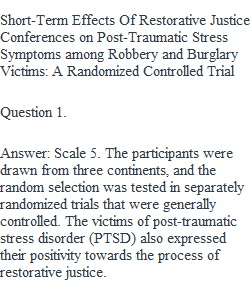


Q (Complete this assignment only after reading Chapter 9, Lecture 5b, and completing all previous assignments in this module.) Now, that you are well-versed in the language of experiments, let's apply what you have learned to an actual criminal justice experiment (true experiments are also called randomized controlled trials, or RCTs). Read the attached article by Caroline Angel and her colleagues (2014). Then use the evaluation questions from Chapter 9 and the knowledge you have gained from the chapter and from Lecture 5b, to evaluate each question below on a scale of 1 to 5 or give an N/A (not applicable) or I/I (insufficient information) when applying it to the study described in Angel et al.'s (2014) article. Make sure to explain your rating for each evaluation question in a couple of sentences. (Copy and paste the questions into a Word file and fill in the answers!) ____ 1. If two or more groups were compared, were the participants assigned at random to the groups? (Explain) ____ 2. If two or more groups were compared, were there enough participants (or aggregate units) per group? (Explain) ____ 3. If two or more comparison groups were not formed at random, is there evidence that they were initially equal in important ways? (Explain) ____ 4. If only a single participant or a single group is used, have the treatments been alternated? (Explain) ____ 5. Are the treatments described in sufficient detail? (Explain) ____ 6. If the treatments were administered by individuals other than the researcher, were those individuals properly trained and monitored? (Explain) ____ 7. If each treatment group had a different person administering a treatment, did the researcher try to eliminate the personal effect? (Explain) ____ 8. If treatments were self-administered, did the researcher check on treatment compliance? (Explain) ____ 9. Except for differences in the treatments, were all other conditions the same in the experimental and control groups? (Explain) ____ 10. Were the effects or outcomes of treatment evaluated by individuals who were not aware of the group assignment status? (Explain) ____ 11. When appropriate, have the researchers considered possible demand characteristics? (Explain) ____ 12. Is the setting for the experiment natural? (Explain) ____ 13. Has the researcher distinguished between random selection and random assignment? (Explain) ____ 14. Has the researcher considered attrition? (Explain) ____ 15. Has the researcher used ethical and politically acceptable treatments? (Explain) ____ 16. Overall, was the experiment properly conducted? (Explain) Attachments o Angel et al., 2014 (restorative justice & victim PTSD; RCT).pdf
View Related Questions